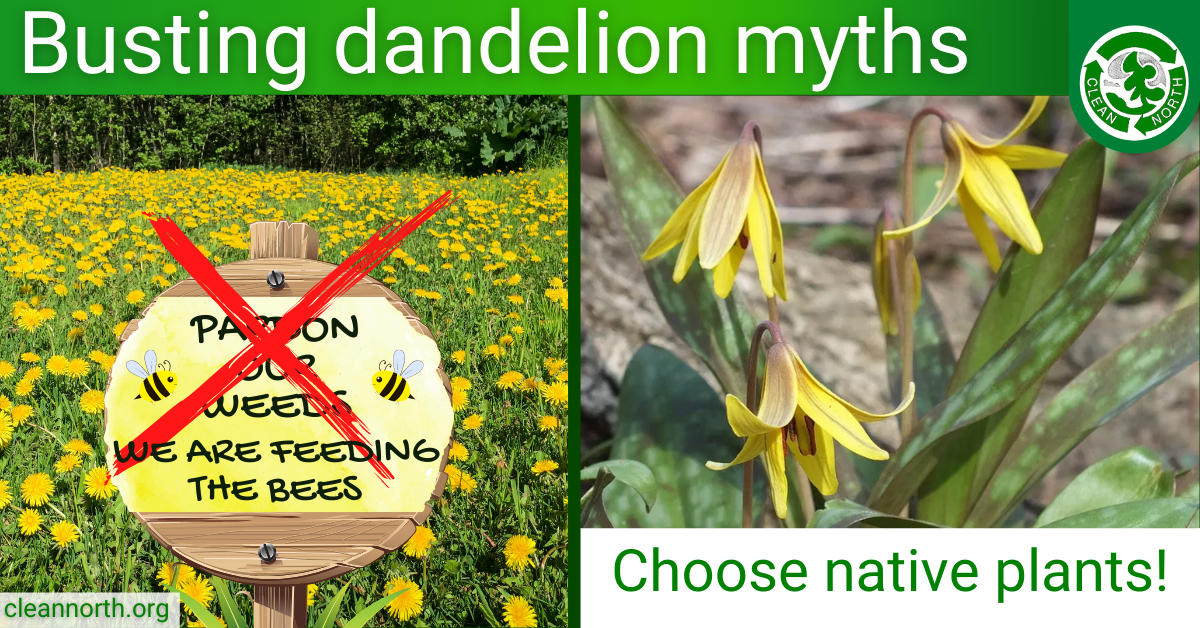
By guest writer Claudette Sims, Halton Master Gardener, and administrator, Master Gardeners of Ontario Facebook Group
Dandelion promo season is about to begin! Every spring there are posts by well-meaning people about how great dandelions are for bees. But are dandelions really good for bees? And what bees are we actually talking about here? Here’s the Good, the Bad and the Ugly answer…
The Good: Yes, there are some positives, with important “buts” attached…
- Dandelions (Taraxacum officinale) are edible and are said to have medicinal properties. But there are lots of native plants with these properties.
- You may have fond memories of making dandelion necklaces, and it is fun to blow the seeds away and make a wish. But you can also blow away seeds of native milkweed and make necklaces with other flowers.
- Some birds may use the dandelion fluff for nesting material. But there are a lot of other fluffy alternatives, e.g. native poplars, willows, so it’s not really needed.
- Dandelion flowers do attract and feed some bees. But more than likely they are non-native honey bees.
- The celebration of dandelions in lawns may spring from a backlash against the use of herbicides in lawns and that is good (herbicide use is still common in the United States). But here in Ontario, the Cosmetic Pesticide Act of 2009 has long banned such spraying, so there is really no need to celebrate dandelions.
The Bad: Recommending dandelions is not cool…
- Dandelions are a non-native species in Canada and much of the United States. They crowd out native plants and are easily dispersed to other people’s gardens by their fluffy seeds.
- Dandelions are very difficult to eliminate from lawns and gardens due to their long tap root.
- Dandelions take up “real estate” in lawns and gardens that could be better served by planting native plants that actually do support native bees. Roughly 25% of native bees are pollen specialists and can only exist on the pollen of a specific genus or variety of plant, e.g., the evening primrose sweat bee (Lasioglossum oenotherae) feeds exclusively on evening primrose (Oenothera biennis).
- Dandelions are pretty well the poster child for what we think of as weeds. Our own Ministry of Agriculture and Rural Affairs lists dandelion as a weed.
- Dandelions make a lawn look “weedy” and are likely the major reason homeowners turn to chemicals for weed management, e.g., chelated iron in products like Weed-B-Gone. These chemicals run off and pollute our watersheds. Even worse, frustrated gardeners may ignore the Ontario Cosmetic Pesticide Act and try and eliminate dandelions in their lawn using non-approved herbicides.
- Dandelions give the movement towards native gardens a bad name as people mistakenly believe native gardens look weedy or neglected.
The Ugly: false and misleading information…
- “We are feeding the bees!” Dandelions didn’t exist in Ontario before Europeans, so they are unnecessary for native bees. In fact, dandelion pollen is detrimental to native bees. When dandelion pollen was fed to solitary bees, larval development was stunted or incomplete.
- “Dandelions are the bees first food” Nonsense! Many plants bloom long before dandelions show their yellow faces, e.g., native elms, willows, poplars, maples, redbuds, serviceberries and fruit trees such as pears, apples and cherries. And each of these trees can have thousands of flowers due to their size, so are a great source of pollen. There is also a long list of spring flowers that bloom before dandelions, e.g., snowdrops, crocus, hyacinths, hellebores, violets, Virginia bluebells, bloodroot.
- “No bees, no food crops for us, and we all starve.” The vast majority of pollination services comes from native wild bees and insects, e.g., solitary bees, bumblebees, flies, and wasps. Since dandelions don’t support our native bees, there is no reason to plant them.
- Dandelion promotion seems to go hand in hand with honey bee promotion. Honey bees actually destabilize natural ecosystems by competing with native bees. While honey bees get the attention in the press and media when there is talk of supporting bees, they are actually a threat to our native bees, many of which are species at risk. I recognize the importance of honey bees to the production of honey and the pollination services beekeepers offer agriculture. But we need to recognize the negative impacts as well. If you truly want to support bees, native pollinators and be bee friendly, just plant native plants. No buts about it!
Want to learn more?
- The Problem with Honey Bees https://www.scientificamerican.com/…/the-problem-with…/
- The Real Scoop on Dandelions and Honeybees https://www.naturesseed.com/…/dandelions-and-honeybees/…
- Are Dandelions Really Important to Bees? https://www.gardenmyths.com/dandelions-important-bees/
- WHAT’S THE BUZZ ON NATIVE BEES? A key underdog in pollination and ecosystems https://www.oursafetynet.org/…/the-buzz-on-native…/…
- Eastern Evening Primrose-Sweat bee https://bugguide.net/node/view/357250
- Pollen Specialist Bees of the Eastern United States https://jarrodfowler.com/specialist_bees.html
- List of crop plants pollinated by bees https://en.wikipedia.org/…/List_of_crop_plants…
- Bee City Canada https://beecitycanada.org/pollinator-resources/
- Heather Holm posters of native plants for bees https://www.pollinatorsnativeplants.com/plant-lists…




